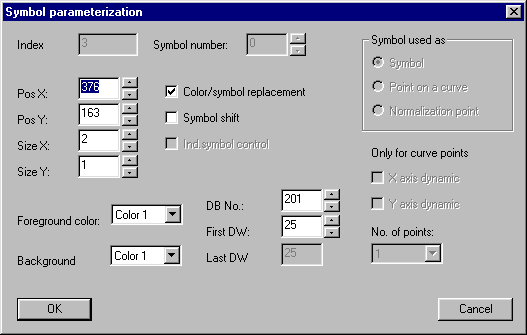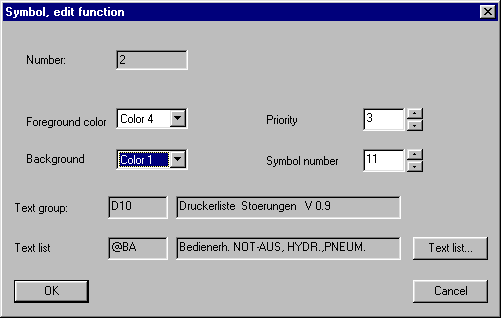
Back to Section: Configuring V fields
The existing symbols of a display are listed in the List of contents, symbols. You can create new symbols from here, and edit, delete and copy symbols. An overview of the functions which are available in this directory are provided under Operator control structure, List of contents, symbols.

The entries in the symbol list of contents are sorted according to the consecutive numbers, both on the PC screen as well as in the process display list which is created. The consecutive numbers are automatically assigned, but can also be indirectly influenced when copying symbols.
The consecutive numbers are decisive for the sequence in which the board is updated in process operation.
The "Type" column specifies whether the symbol is static, dynamic, indirect (i.e. controlled by message bits), or is used as point on a curve.
Note:
The symbol list of contents corresponds to the operator control level "Selecting a process display element" of the CP/M / MSDOS configuring software (also refer to the Planning Guide for WF470, Section 7.2.9.).
Select the menu item File/New in the List of contents, symbols. The dialog box for Parameterizing symbols is opened.
To edit the parameter, select the appropriate entry in the List of contents, symbols and select the menu item File/Open . The dialog box of the dialog box for Parameterizing symbols is then opened.
You can also open the symbol by double-clicking on the entry.
To copy a symbol, select the appropriate entry in the List of contents, symbols, and select the menu item Edit/Copy . The selected symbol is then copied into the WINDOWS clipboard.
Then select the symbol after which you wish to paste the symbol you copied. Then select the menu item Edit/Paste . The symbol to be copied is copied from the WINDOWS clipboard to the location which you selected. If required you can then edit the parameters of the copied symbol (refer to "Parameterizing symbols").
Notes:
A symbol is moved (within the list of contents or the display list) the same as when copying; however, the original symbol is deleted.
To move a symbol first select the menu item Edit/Cut instead of Edit/Copy.
It can be practical to move a symbol in order to influence its consecutive number and therefore the sequence in which the display is updated in process operation.
To delete a symbol, select the appropriate entry in the List of contents, symbols and select the menu item File/Delete. The selected symbol is then deleted.
To set-up or change a symbol control function for a symbol, select the appropriate entry in the List of contents, symbols and select the menu item Edit/Symbol control list. The List of contents, symbol control functions for this symbol is then opened, from where you can then configure the symbol control functions.

In this dialog box, you can set all of the parameters of a symbol. Depending on the use of the symbol, specific dialog box elements cannot be used (gray).
For dynamic symbols, the number of data words that the symbol requires, is displayed. You can also see this information in the List of contents, symbols. A symbol is (directly) dynamic, if color/symbol replacement and/or symbol move are permitted.
This dialog box also takes into account the use of symbols as points on a curve. A symbol is interpreted as a point on a curve, if:
The "indirect symbol control" check box indicates whether text lists are assigned to the symbol for indirect symbol control (= symbol control functions). Direct dynamic properties and indirect symbol control are not permitted for the same symbol and are therefore mutually interlocked.
The set parameters are transferred after acknowledging using the "OK" button.
You’ll find additional information on the symbol parameters in the Planning Guide for WF470, Section 7.4. and in the document "WF470 Video display Module", Technical Description, Section 4.9 when used as points on a curve.
The symbol control functions for a symbol are listed in the list of contents of the symbol control functions. From here, you can create new symbol control functions, delete and copy symbol control functions. An overview of the functions available in this directory are provided under Operator control structure, List of contents, symbols.

A maximum of 10 symbol control functions can be parameterized for a symbol. The display build-up time on the WF470 can be optimized by assigning priorities corresponding to the consecutive number (1 = lowest, 8 = highest priority).
Notes:
Additional information on the symbol control functions are provided in the Planning Guide for WF470, Section 7.9.
In the List of contents, symbol control functions, select the menu item File/New. The dialog box for Parameterizing the symbol control function is opened.
To edit the parameter select the appropriate entry in the List of contents, symbol control functions and select the menu item File/Open . The dialog box for the dialog box to Parameterizing the symbol control function is opened.
You can also open the symbol control function by double-clicking on the entry.
To copy a symbol control function, select the appropriate entry in the List of contents, symbol control functions and select the menu item Edit/Copy . The selected symbol control function is then copied into the WINDOWS clipboard.
Then select the symbol control function, after which you wish to paste the symbol control function to be copied. Then select the menu item Edit/Paste . The symbol control function to be copied is copied from the WINDOWS clipboard to the location which you selected. You can then, if required, edit the parameters of the copied symbol control function (refer to "Parameterizing the symbol control function").
Notes:
A symbol control function is moved (within the list of contents or the display list) essentially the same as when copying; however, the original symbol control function is deleted.
To move a symbol control function, first select the menu item Edit/Cut instead of Edit/Copy.
It can be practical to move a symbol control function in order to influence its consecutive number and therefore the processing sequence when building-up the display and display update in process operation (also refer to the notes under List of contents, symbol control functions).
To delete a symbol control function, select the appropriate entry in the List of contents, symbol control functions and select the menu item File/Delete. The selected symbol control function is then deleted.

You can set the parameters of a symbol control function in this dialog box.
The consecutive number of the symbol control function is specified in the "Number" field. The priority should be assigned corresponding to the consecutive number. Also refer to the notes in the Section List of contents, symbol control functions.
In the "Symbol number" combo box, select the number of the symbol for the symbol replacement. If a symbol replacement is not to be configured, then, contrary to CP/M / MSDOS configuration, the symbol number specified here must correspond to the symbol number of the symbol to be edited. When creating a new symbol control function, the symbol number is appropriately pre-assigned.
For large symbols the "Symbol number" combo box is not used, as symbol replacement cannot be configured.
In order to assign the text group and text list, press the "Text list..." button. The "Text list assignment" dialog box is then selected, in which you can select the text group and text list.
The set parameters are transferred after acknowledging using the "OK" button.
You’ll find additional information on the parameters for a symbol control function in the Planning Guide for WF470, Section 7.9.2.
To the next Section: List of contents, large symbols